|
Canadian Pacific 2317 Tire Change
Photographs by Ken Ganz - Author unknown.
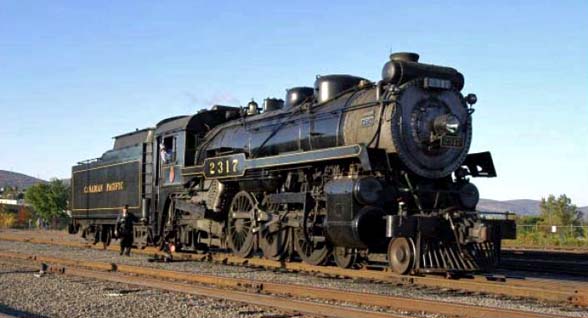
Canadian Pacific Railway 4-6-2 Pacific class G3c number 2317 at Steamtown in Scranton,
Pennsylvania.
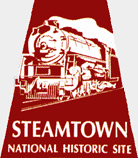
 Introduction Introduction
Currently (April 2011),
Canadian Pacific steam locomotive number 2317 is out-of-service at
Steamtown in Scranton, Pennsylvania, USA, due to a 1,472-day American Federally mandated inspection requirement. But back in 2007 the
locomotive received a new set of tires for its driving wheels. The story that follows describes the process of a tire change, nothing like
a tire change one would perform on a car. Read on...
 Tire
Change Tire
Change
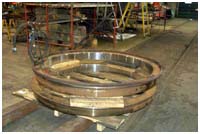 On 14 Mar 2007 the Steamtown Locomotive Shop
staff replaced two tires on the main drive wheels of Canadian Pacific 2317. The old tires were "sweated" off, new ones
installed, and then re-cut to the proper diameter. This virtual tour shows how the new tire is put on the drive wheel. These are two new
tires for Canadian Pacific 2317. New tires may be needed for many reasons, the tire or the flange is too thin (possibly from too many
re-shaping's on a lathe) or the tire is damaged. Canadian Pacific 2317's third drive axle's tires had very thin
flanges. On 14 Mar 2007 the Steamtown Locomotive Shop
staff replaced two tires on the main drive wheels of Canadian Pacific 2317. The old tires were "sweated" off, new ones
installed, and then re-cut to the proper diameter. This virtual tour shows how the new tire is put on the drive wheel. These are two new
tires for Canadian Pacific 2317. New tires may be needed for many reasons, the tire or the flange is too thin (possibly from too many
re-shaping's on a lathe) or the tire is damaged. Canadian Pacific 2317's third drive axle's tires had very thin
flanges.
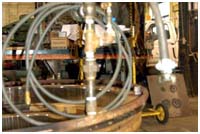 The tire is cut 55/1000s of an inch smaller
than the wheel it will be fit on. Steel expands when it is heated, so a gas ring will be fitted around the
tire. The tire is cut 55/1000s of an inch smaller
than the wheel it will be fit on. Steel expands when it is heated, so a gas ring will be fitted around the
tire.
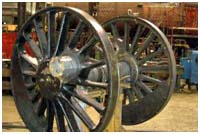 Just like a car, only the tire is replaced.
The wheels are individual sand-castings and, even a hundred years ago, were very expensive. The thin rolled-steel ring (the tire) is much
cheaper. A stand holds the wheel set (wheels and axle) off the
floor. Just like a car, only the tire is replaced.
The wheels are individual sand-castings and, even a hundred years ago, were very expensive. The thin rolled-steel ring (the tire) is much
cheaper. A stand holds the wheel set (wheels and axle) off the
floor.
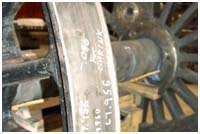 Each tire is cut for one, and only one, wheel.
Wheels on the same axle can be off by a hundredth on an inch or more, so when the inner diameter of the tire is trimmed (it must be
55/1000's of an inch smaller than the wheel), it must match the wheel. This drive wheel is 67.956 inches in diameter (5 feet 7
inches). Each tire is cut for one, and only one, wheel.
Wheels on the same axle can be off by a hundredth on an inch or more, so when the inner diameter of the tire is trimmed (it must be
55/1000's of an inch smaller than the wheel), it must match the wheel. This drive wheel is 67.956 inches in diameter (5 feet 7
inches).
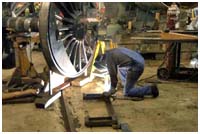 A Steamtown Preservation Specialist creates a
bracket to help install the tire. The bracket fits on the forks of a forklift and hold the tire against the wheel during the heating
process. Often, Steamtown's Locomotive Shop staff must create a tool before working with these historic
machines. A Steamtown Preservation Specialist creates a
bracket to help install the tire. The bracket fits on the forks of a forklift and hold the tire against the wheel during the heating
process. Often, Steamtown's Locomotive Shop staff must create a tool before working with these historic
machines.
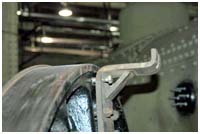 This bracket, made in the Steamtown Locomotive
Shop, holds the new tire slightly above the wheel. When the tire is heated to the proper temperature, and has expanded, workers slide it
onto the wheel using sledge
hammers. This bracket, made in the Steamtown Locomotive
Shop, holds the new tire slightly above the wheel. When the tire is heated to the proper temperature, and has expanded, workers slide it
onto the wheel using sledge
hammers.
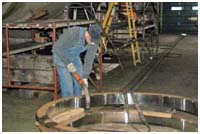 A Steamtown Preservation Specialist positions
a lifting band on a
tire. A Steamtown Preservation Specialist positions
a lifting band on a
tire.
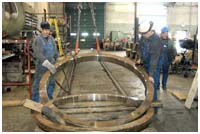 The new tire is relatively light (only a few
hundred pounds) so the small hook on the overhead crane is used. This must be done slowly and carefully to avoid damaging the rolled
steel tire. The new tire is relatively light (only a few
hundred pounds) so the small hook on the overhead crane is used. This must be done slowly and carefully to avoid damaging the rolled
steel tire.
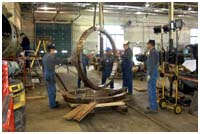 As the tire is lifted to vertical, any
oscillations are damped to prevent
damage. As the tire is lifted to vertical, any
oscillations are damped to prevent
damage.
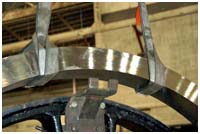 The tire is lowered onto the bracket. After
the straps are removed, the next step is placement of the gas
ring. The tire is lowered onto the bracket. After
the straps are removed, the next step is placement of the gas
ring.
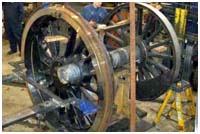 The gas ring is in place around the new tire.
Fed by hoses at the bottom, the gas/oxygen mixture travels though the ring and out small
holes. The gas ring is in place around the new tire.
Fed by hoses at the bottom, the gas/oxygen mixture travels though the ring and out small
holes.
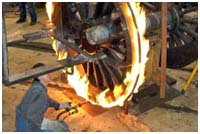 The flame is lit and swiftly envelops the new
tire. The flame is lit and swiftly envelops the new
tire.
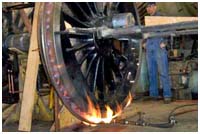 The flow of oxygen is cut back to produce a
bluish flame which burns much
hotter. The flow of oxygen is cut back to produce a
bluish flame which burns much
hotter.
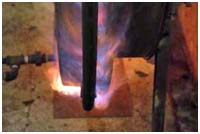 A close up of the flames at the bottom of the
new tire. The new tire must be heated to about 200 to 250 degrees F above the ambient temperature to expand enough to slide over the
wheel. A close up of the flames at the bottom of the
new tire. The new tire must be heated to about 200 to 250 degrees F above the ambient temperature to expand enough to slide over the
wheel.
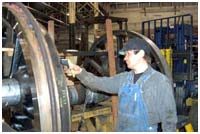 A Steamtown Preservation Specialist uses a
sensor to check the temperature of the steel wheel. The wheel must be hot enough (around 300 to 350 degrees F) to expand, but must not
exceed 600 degrees. Above 600 degrees, the temperature may change the steel altering how much it can
flex. A Steamtown Preservation Specialist uses a
sensor to check the temperature of the steel wheel. The wheel must be hot enough (around 300 to 350 degrees F) to expand, but must not
exceed 600 degrees. Above 600 degrees, the temperature may change the steel altering how much it can
flex.
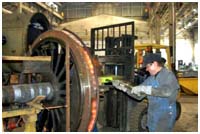 A Steamtown Preservation Specialist uses a
sledgehammer to move the tire onto the wheel. Steam railroading is an odd combination of measuring to within a thousandth of an inch, and
then using a large blunt tool to achieve
results. A Steamtown Preservation Specialist uses a
sledgehammer to move the tire onto the wheel. Steam railroading is an odd combination of measuring to within a thousandth of an inch, and
then using a large blunt tool to achieve
results.
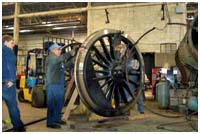 The gas ring is removed and workers check to
ensure the tire is fully on the
wheel. The gas ring is removed and workers check to
ensure the tire is fully on the
wheel.
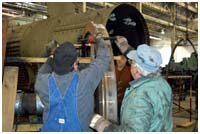 Workers ensure that the new tire is properly
mounted on the
wheel. Workers ensure that the new tire is properly
mounted on the
wheel.
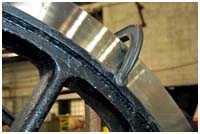 Clamps hold the tire in place on the wheel as
it cools. As the tire shrinks onto the wheel tension between the tire and wheel holds the tire in
place. Clamps hold the tire in place on the wheel as
it cools. As the tire shrinks onto the wheel tension between the tire and wheel holds the tire in
place.
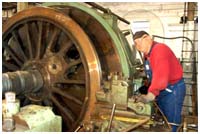 A Steamtown Volunteer-in-Park (VIP) uses a
wheel lathe to cut the new tires. Only one set of tires (one axle) is being replaced and all the drive wheels of a steam locomotive must
be the same diameter because they are linked with connecting
rods. A Steamtown Volunteer-in-Park (VIP) uses a
wheel lathe to cut the new tires. Only one set of tires (one axle) is being replaced and all the drive wheels of a steam locomotive must
be the same diameter because they are linked with connecting
rods.
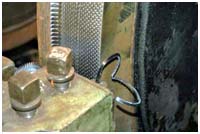 As the drive wheel set rotates in the lathe,
a cutting blade removes a quarter-inch deep "shaving" from the new tire. When the diameter approaches the size of the old tire,
a different blade does the final
shaping. As the drive wheel set rotates in the lathe,
a cutting blade removes a quarter-inch deep "shaving" from the new tire. When the diameter approaches the size of the old tire,
a different blade does the final
shaping.
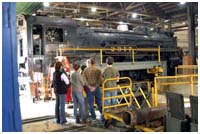 Canadian Pacific 2317 rests in the shop as
visitors tour the facility. Canadian Pacific 2317 rests in the shop as
visitors tour the facility.
Thank you for your time. We hope you enjoyed this "virtual tour" showing one of many activities in Steamtown's Locomotive Shop.
Steamtown offers walking tours of the Locomotive Shop on most days. Some lucky visitors were able to see the "ring of fire"
during their tour.
 Associated Web
Sites Associated Web
Sites
Steamtown National Historic
Site
Canadian Pacific
Railway
|